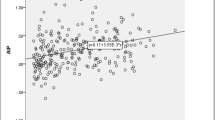Abstracts
Hypertension induced by obstructive sleep apnea (OSA) may be multifactorial in origin, and systemic inflammation is one of the major factors. However, OSA patients do not always have the identical probability with hypertension even in patients with the same history and degree of OSA. The aim of this study was to compare the levels of inflammation and insulin resistance in two groups of patients who had the same degree as well as the same long history of OSA, but with/without hypertension. OSA patients (Apnea Hyponea Index, AHI ≥ 40/h, n = 70) were examined by polysomnography and blood analysis for the measurements of fasting plasma glucose, serum insulin (FINS), high-sensitivity C-reactive protein (CRP), peptide C,TNF-α, IL-6, and IL-10. Patients with hypertension (n = 40) had higher level of LDL-C and lower HDL-C levels than patients without hypertension. Almost half (16/40) of OSA patients with hypertension had family history of hypertension. Moreover in OSA patients with hypertension, the levels of TNF-α, IL-6, and CRP were higher, but IL-10 was lower than those without hypertension. FINS, peptide C, HOMA-IR, and HOMA-islet were also higher in OSA patients with hypertension. OSA patients with hypertension have higher level of inflammation and insulin resistance. Systemic inflammation and insulin resistance are both important factors for the development of hypertension in OSA patients.
Similar content being viewed by others
REFERENCES
Kono, M., K. Tatsumi, T. Saibara, et al. 2007. Obstructive sleep apnea syndrome is associated with some components of metabolic syndrome. Chest 131: 1387–1392.
Hidekatsu, Y., T. Yoshiharu, I. Kumie, et al. 2008. The underlying mechanisms for development of hypertension in the metabolic syndrome. Nutrition Journal 7: 10. doi:10.1186/1475-2891-7-10.
Lam, J.C.M., and S.M.Ip. Mary. 2010. Sleep and the metabolic syndrome. Indian Journal of Medical Research 131: 206–216.
Pepperell, J.C., R.J. Davies, and J.R. Stradling. 2002. Systemic hypertension and obstructive sleep apnoea. Sleep Medicine Reviews 6: 157–173.
Haas, D.C., G.L. Foster, F.J. Nieto, et al. 2005. Age-dependent associations between sleep disordered breathing and hypertension. Circulation 111: 614–621.
Esra, Tasali, and M.S.M. Ip. 2008. Obstructive sleep apnea and metabolic syndrome: alterations in glucose metabolism and inflammation. Proceedings of the American Thoracic Society 5: 207–217.
Kahaleh, M.B., and P.S. Fan. 1997. Effect of cytokines on the production of endothelin by endothelial cells. Clinical and Experimental Rheumatology 15: 163–167.
Brasier, A.R., J. Li, and K.A. Wimbish. 1996. Tumor necrosis factor activates angiotensinogen gene expression by the Rel A transactivator. Hypertension 27: 1009–1017.
Zinman, B., A.J. Hanley, S.B. Harris, et al. 1999. Circulating tumor necrosis factor-alpha concentrations in a native Canadian population with high rates of type 2 diabetes mellitus. Journal of Clinical Endocrinology and Metabolism 84: 272–278.
Dorffel, Y., C. Latsch, B. Stuhlmuller, et al. 1999. Preactivated peripheral blood monocytes in patien with essential hypertension. Hypertension 34: 113–117.
Papanicolaou, D.A., J.S. Petrides, C. Tsigos, et al. 1996. Exercise stimulates interleukin-6 secretion: inhibition by glucocorticoids andcorrelation with catecholamines. American Journal of Physiology 271: E601–E605.
Besedovsky, H.O., and A. del Rey. 1996. Immune-neuro-endocrine interactions: facts and hypotheses. Endocrine Reviews 17: 64–102.
Takano, M., N. Itoh, K. Yayama, et al. 1993. Interleukin-6 as a mediator responsible for inflammation induced increase in plasma angiotensinogen. Biochemical Pharmacology 45: 201–206.
Punjabi, N.M., and B.A. Beamer. 2007. C-reactive protein is associated with sleep disordered breathing independent of adiposity. Sleep 30: 29–34.
Can, M., S. Acikgoz, G. Mungan, et al. 2006. Serum cardiovascular risk factors in obstructive sleep apnea. Chest 129: 233–237.
Katagiri, H., T. Yamada, and Y. Oka. 2007. Adiposity and cardiovascular disorders: disturbance of the regulatory system consisting of humoral and neuronal signals. Circulation Research 101: 27–39.
Tauman, R., L.M. O’Brien, and D. Gozal. 2007. Hypoxemia and obesity modulate plasma C-reactive protein and interleukin-6 levels in sleep-disordered breathing. Sleep & Breathing 11: 77–84.
Mosser, D.M., and X. Zhang. 2008. Interleukin-10: new perspectives on an old cytokine. Immunology Reviews 226: 205–218.
Gozal, D., and L. Kheirandish-Gozal. 2008. Cardiovascular morbidity in obstructive sleep apnea. American Journal of Respiratory and Critical Care Medicine 177: 369–375.
Tinsley, J.H., S. South, and V.L. Chiasson. 2010. Interleukin-10 reduces inflammation, endothelial dysfunction, and blood pressure in hypertensive pregnant rats. American Journal of Physiology - Regulatory, Integrative and Comparative Physiology 298: 713–719.
Matsuzawa, Y. 2010. Establishment of a concept of visceral fat syndrome and discovery of adiponectin. Proceedings of the Japan Academy. Series B, Physical and Biological Sciences 86: 131–141.
Tilg, H., and A.R. Moschen. 2008. Inflammatiory mechanisms in the regulation of insulin resistance. Molecular Medicine 14: 222–231.
Wellen, K.E., and G.S. Hotamisligil. 2005. Inflammation, stress, and diabetes. The Journal of Clinical Investigation 115: 1111–1119.
DeFronzo, R.A., C.R. Cooke, R. Andres, et al. 1975. The effect of insulin on renal handling of sodium, potassium, calcium, and phosphate in man. The Journal of Clinical Investigation 55: 845–855.
Sechi, L.A. 1999. Mechanisms of insulin resistance in rat models of hypertension and their relationships with salt sensitivity. Journal of Hypertension 17: 1229–1237.
Strazzullo, P., A. Barbato, F. Galletti, et al. 2006. Abnormalities of renal sodium handling in the metabolic syndrome. Results of the Olivetti Heart Study. Journal of Hypertension 24: 1633–1639.
Rocchini, A.P. 2000. Obesity hypertension, salt sensitivity and insulin resistance. Nutrition, Metabolism, and Cardiovascular Diseases 10: 287–294.
ACKNOWLEDGMENTS
This work was supported by the National Natural Science Foundation of China (no. 30971259).
Conflict of Interest
No potential conflict of interest relevant to this article was reported.
Author information
Authors and Affiliations
Corresponding authors
Additional information
Summary at glance
OSA patients with hypertension (n = 40) have higher level of inflammation and insulin resistance than OSA patients without hypertension (n = 30). Systemic inflammation and insulin resistance are both important factors for the development of hypertension in OSA patients.
Xiaoshun Qian and Tong Yin, as co-first authors, contribute equally to this manuscript.
Rights and permissions
About this article
Cite this article
Qian, X., Yin, T., Li, T. et al. High Levels of Inflammation and Insulin Resistance in Obstructive Sleep Apnea Patients with Hypertension. Inflammation 35, 1507–1511 (2012). https://doi.org/10.1007/s10753-012-9464-3
Published:
Issue Date:
DOI: https://doi.org/10.1007/s10753-012-9464-3




